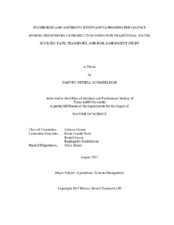| dc.contributor.advisor | Gomes, Carmen | |
| dc.creator | Summerlin III, Harvey Newell | |
| dc.date.accessioned | 2018-02-05T21:10:43Z | |
| dc.date.available | 2019-08-01T06:53:38Z | |
| dc.date.created | 2017-08 | |
| dc.date.issued | 2017-06-27 | |
| dc.date.submitted | August 2017 | |
| dc.identifier.uri | https://hdl.handle.net/1969.1/165775 | |
| dc.description.abstract | A growing population and demand for food force agricultural leaders to look for alternative water sources. Wastewater reuse could be introduced into commercial operations, if regulations and measures are in place to ensure food safety. The objective of this project was to grow and irrigate lettuce with wastewater to track the fate of Escherichia coli and AP205 bacteriophage during and after cultivation to assess their fate and transport. Subsequently, quantitative microbial risk assessment (QMRA) was performed to estimate risk of illness to the public. Contamination levels in foliage, leachate, and soil were directly (P < 0.05) related to initial concentrations of microorganisms in the irrigation water. E. coli concentrations during post-harvest storage (14 days at 4 oC) of foliage increased by over 400%, while AP205 concentrations decreased more than 2 logs. From randomly selected E. coli colonies, in all four biomass types, 81% and 34% showed resistance to ampicillin and cephalothin, respectively. QMRA revealed significant health risks associated with lettuce consumption. E. coli concentrations were used as a fecal indicator bacteria to estimate levels of 6 common pathogens in wastewater and AP205 concentrations were used to estimate norovirus and rotavirus levels. Norovirus and Giardia largely contributed to the 0.8 probability of illness developing from infection, while norovirus and rotavirus showed a 0.24-0.43 probability of illness developing from infection, when using E. coli and AP205 concentrations, respectively. Results show that non-traditional water usage for fresh produce cultivation can pose risks to humans, if standards are not in place to control pathogen contamination levels. | en |
| dc.format.mimetype | application/pdf | |
| dc.language.iso | en | |
| dc.subject | Wastewater | en |
| dc.subject | Produce Irrigation | en |
| dc.subject | Pathogen Prevalence | en |
| dc.subject | Antibiotic Resistance Bacteria | en |
| dc.subject | Microbial Risk Assessment | en |
| dc.subject | Bacteriophage | en |
| dc.title | Foodborne and Antibiotic Resistant Pathogens Prevalence During Fresh Produce Production Using Non-Traditional Water Sources: Fate, Transport, and Risk Assessment Study | en |
| dc.type | Thesis | en |
| thesis.degree.department | Biological and Agricultural Engineering | en |
| thesis.degree.discipline | Agricultural Systems Management | en |
| thesis.degree.grantor | Texas A & M University | en |
| thesis.degree.name | Master of Science | en |
| thesis.degree.level | Masters | en |
| dc.contributor.committeeMember | Lacey, Ronald | |
| dc.contributor.committeeMember | Castell-Perez, Elena | |
| dc.contributor.committeeMember | Karthikeyan, Raghupathy | |
| dc.type.material | text | en |
| dc.date.updated | 2018-02-05T21:10:44Z | |
| local.embargo.terms | 2019-08-01 | |
| local.etdauthor.orcid | 0000-0001-6959-3754 | |


